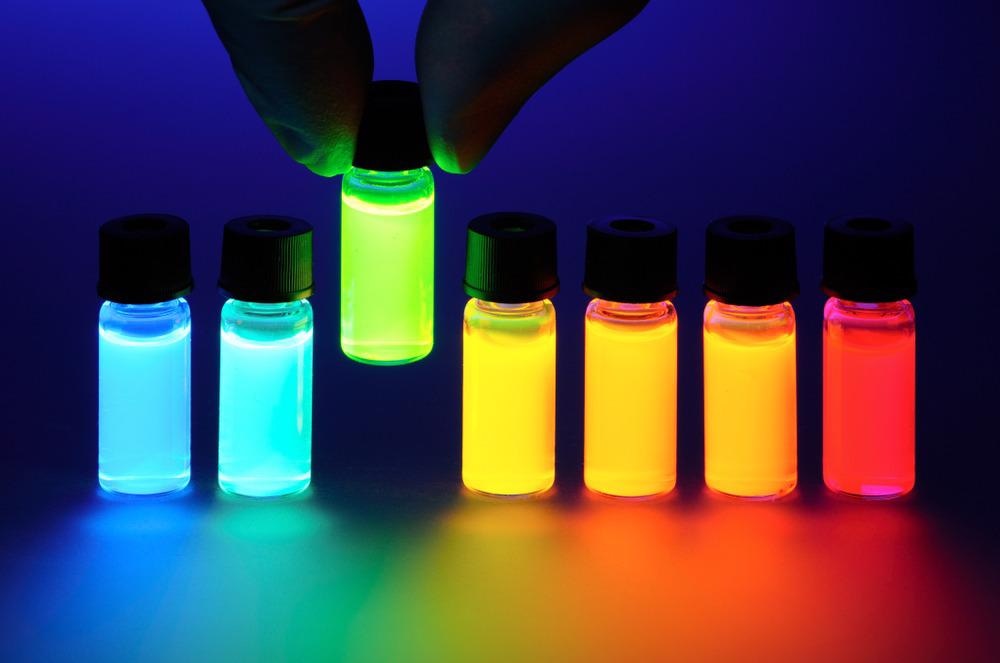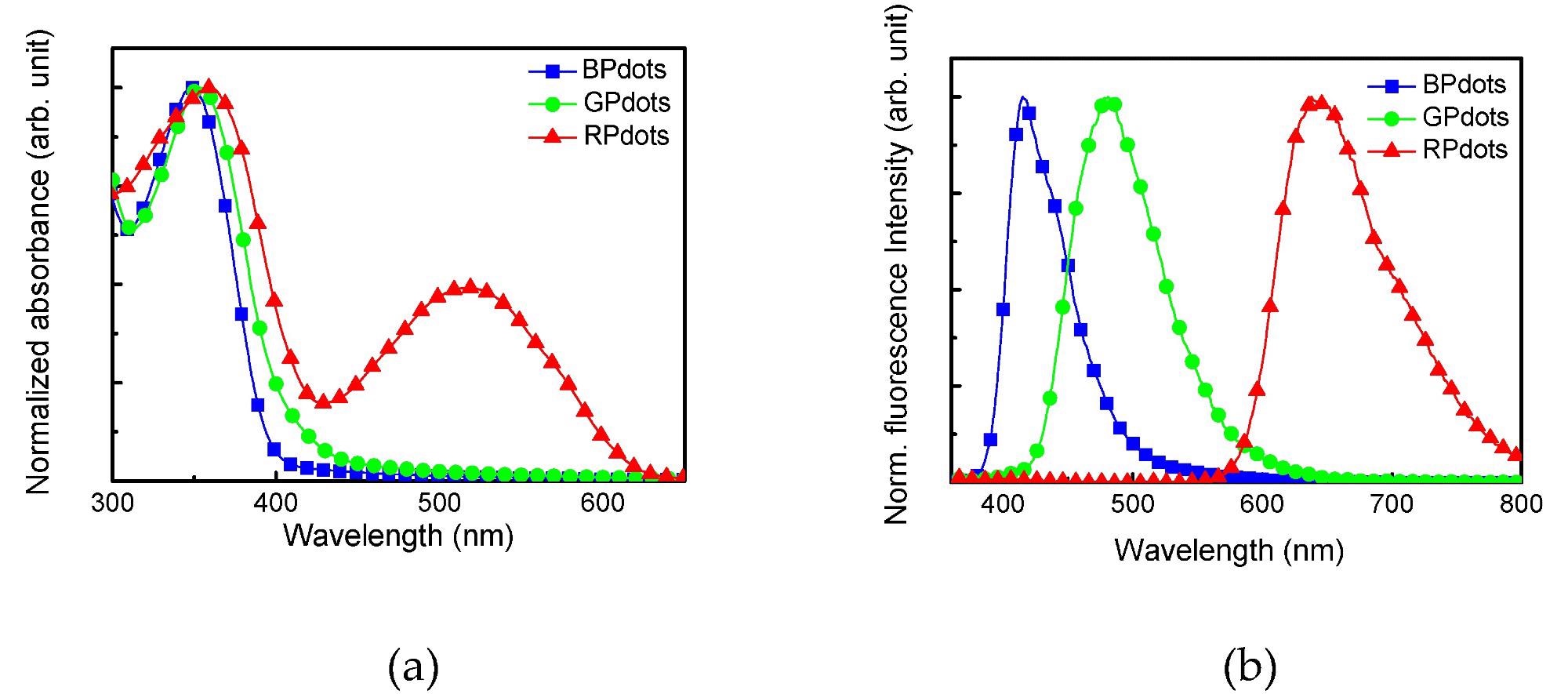The Suzuki linking polymerization method was used to create a sequence of conjugated polymers (CPs) that exhibit red, green, and blue (RGB) fluorescence as per the latest research in the journal Polymers.

Study: Fluorescence Modulation of Conjugated Polymer Nanoparticles Embedded in Poly(N-Isopropylacrylamide) Hydrogel. Image Credit Denis Larkin/Shutterstock.com
The reprecipitation process was used to make polymer dots (Pdots) from matching CPs, with the Pdot surface-functionalized with an allyl moiety.
As the CP structures were founded on the phenylene group, the Pdots had equal ultraviolet-visible attenuation at 350 nm, suggesting that the same excitation wavelength could be employed.
Pdots were chemically incorporated in poly(N-isopropylacrylamide) (PNIPAM) hydrogel before being used as a thermoresponsive component in the polymer hydrogel. The polymer hydrogel might provide thermally reversible fluorescence changes with RGB emissions hues.
Importance of Conjugated Polymer Nanoparticles
Owing to their distinctive photonic capabilities, conjugated polymer nanoparticles (CPNs) have been effectively synthesized and employed in the biomedical sector in recent years. CPNs' quick growth is mostly due to their simple synthesis techniques and facile separation stages. CPNs have several benefits, including great brightness, outstanding photostability, minimal toxicity, excellent quantum efficiency, and variable surface functionalization.
Environmental Change Detection
The monitoring of environmental factors has received much attention. Polymeric hydrogels that cope with environmental stimuli are gaining popularity due to their beneficial uses in the delivery of drugs, biochemical and biosensors, adsorption, shape control, and color tweaking. Illumination, physical strain, pH, and heat may all change the physical and chemical characteristics of these sensitive polymer hydrogels.

(a) UV-vis and (b) fluorescence spectra of Pdots in water. Excitation wavelength 350 nm. Image Credit: Namgung, H., Jo, S. & Lee, T. S.
Advantages of Poly(N-isopropylacrylamide) Hydrogels
Poly(N-isopropylacrylamide) (PNIPAM) is widely recognized amongst hydrogels for its outstanding thermal sensitivity. PNIPAM exhibits a lower critical solution temperature (LCST) of roughly 32 degrees in an aqueous media. Because its polymer chains are completely stretched with random helix shape, the polymer is water-soluble below LCST.
At temperatures over the LCST, PNIPAM shrinks because of the hydrophobic interaction. This property qualifies PNIPAM-based hydrogels for application in drug-delivery systems.
The current research describes thermoresponsive fluorescence tuning of Pdots in a PNIPAM-based hydrogel. Thermally sensitive fluorescence tweaking in the hydrogel with several fluorophores was found achieved different emission colors. To accomplish temperature-dependent fluorescence adjustment, graphene oxide was utilized as a fluorescent quencher.

Polymerization of PNIPAM on the surface of Pdots@AA via emulsion polymerization. Image Credit: Namgung, H., Jo, S. & Lee, T. S.
Research Findings
Monomers with dibromo units (M1, M2, and M3) were synthesized using techniques described in the literature. Abundant organic solutions, such as CHCl3, dissolved the CPs. GCP had UV-vis absorbing frequencies of 350 nm and fluorescent frequencies of 415 and 490 nm. The solid-state of CP produced findings that were extremely comparable to those obtained in the solutions. BCP, GCP, and RCP fluoresced blue, green, and red at 415, 475, and 633 nm, correspondingly, with an equal wavelength range of 350 nm.

Changes in the (a) hydrodynamic diameters and (b) relative fluorescence intensities (Ix/Ii) of BPdots@PNIPAM (■), GPdots@PNAIPAM (●), and RPdots@PNAIPAM (▲) in aqueous solution over repeated heating (45 °C) and cooling (25 °C) cycles. di and dx correspond to hydrodynamic diameters at 25 °C and at elevated temperatures, respectively. Ii and Ix correspond to fluorescent intensities (at 415 nm for BPdots@PNAIPAM; 475 nm for GPdots@PNAIPAM; 625 nm for RPdots@PNAIPAM) at 25 °C and at elevated temperature, respectively. Image Credit: Namgung, H., Jo, S. & Lee, T. S.
The reprecipitation process was used to produce Pdots. Carboxylic acid groups might be formed during Pdot synthesis. The Pdots were disseminated evenly in an aqueous solution without agglomeration, although their UV-vis and emission spectra matched those of their solid states. The zeta capabilities were discovered to be unfavorably attributed to the prevalence of the carboxylic acid group on the Pdot surface.
The hydrodynamic radii of Pdots@PNIPAM decreased with the increase in temperature, regardless of the type of Pdot, with a sharp reduction at around 34 degrees, which is the LCST of PNIPAM, caused by PNIPAM shrinkage.
The fluorescent strength of three Pdots@PNIPAM progressively reduced as temperature increased. The fluorescence intensity of Pdots@PNIPAM over LCST was thought to be disrupted by the shrinking of PNIPAM chains. The contraction of the polymeric chains caused the clustering of Pdots@PNIAPM, resulting in a murky solution.
In summary, BCP, GCP, and RCP were manufactured into Pdots with RGB fluorescent hues after emitting three primary colors via the Suzuki coupling procedure. PSMA was used to surface-functionalize the Pdots with the carboxylic acid group. Over numerous heating/cooling phases, the contraction and fluorescence reduction were bidirectional, demonstrating that Pdots@PNIPAM possessed thermo-responsibility.
Continue reading: Shedding Light on Perovskite Nanocrystal Properties.
Reference
Namgung, H., Jo, S. & Lee, T. S., (2021) Fluorescence Modulation of Conjugated Polymer Nanoparticles Embedded in Poly(N-Isopropylacrylamide) Hydrogel. Polymers, 13(24). 4315. Available at: https://www.mdpi.com/2073-4360/13/24/4315/htm
Disclaimer: The views expressed here are those of the author expressed in their private capacity and do not necessarily represent the views of AZoM.com Limited T/A AZoNetwork the owner and operator of this website. This disclaimer forms part of the Terms and conditions of use of this website.